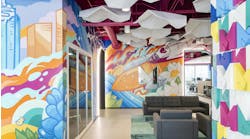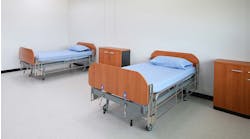Imagine this scenario: A major painting touch-up or project needs to be done in your building—but it’s not feasible to close off that particular space. As a result, you need to continue on with the project in a manner that’s as least disruptive as possible to the building’s daily operations.
If it’s something you see happening in your near future, make sure you’re taking the necessary precautions to complete the job safely and quickly.
Your project can range from a simple touch-up to a complete interior repaint for a renovation. But no matter the scope, the health and safety of both your occupants and staff is the priority.
[Related: 4 Tips for the Best Lighting for Indoor Plants]
Painting and Indoor Air Quality
When you’re painting in a high-traffic area during operating hours, maintaining indoor air quality (IAQ) is especially important. Paint products that are labeled as having low or no VOCs (volatile organic compounds) are ideal. They’ll give off less odor, allowing you to paint with less disruption.
Rick Watson, director of product and technical information at Sherwin-Williams, also recommends using products that are GREENGUARD certified, meaning they have low chemical emissions and can improve IAQ. GREENGUARD Gold accounts for sensitive individuals, such as children and the elderly. These products are ideal for schools and healthcare facilities.
Watson contends that odors are subjective, so it’s possible tenants still won’t be completely comfortable. “Ultimately, somebody is going to complain no matter what you use,” he says.
In search of painting supplies? Check these out.
To that end, always make sure windows and doors are open to get as much air movement as possible. Use fans to remove odors. And find products that are proven to be quick-drying.
Setting a Schedule
To avoid any major disruption, Watson recommends working on painting projects when there is a least amount of foot traffic as possible.
BUILDINGS Podcast
Health Risks of 3D Printers
Based off a research report conducted by Georgia Tech and UL Chemical Safety, Sarah Kloepple and Christoph Trappe chat about the rising popularity of 3D printers for businesses, schools and personal use.
They discuss the health risks associated with these printers as well as some tips to keep everyone safe. Listen now >>
“If we know that at 8 o’clock in the morning people are coming in and getting their coffee, you start painting too early in the morning, in some cases people are going to complain,” he explains. “Consider that maybe we need to paint at a time when people are distracted. If there’s a big meeting going on, then potentially that could be a great time to paint for an hour or two, when people are distracted that way. Work toward the end of day, like starting at 3 p.m.”
Product Quality
Watson says selecting a high-quality painting product can make a difference. Make sure the paint is durable and can withstand frequent washing and cleaning. There’s likely more of an upfront cost on these products, but that also means less maintenance time and money spent on touch-ups or repaints.
“Quality can lead significantly to a longer lifecycle, and sometimes people don’t realize that,” Watson says. “[High-quality paint] plays a major role in facilities managers’ buildings. I think that’s something that’s overlooked.”
Paint Like a Pro
Maintenance projects are often a balance of give and take. You need to improve the performance and aesthetics of a certain space or piece of equipment, but that might mean interrupting occupants’ daily activities or taking the space or equipment offline all together.
Painting projects are no different. But there are ways you can make it less disruptive—from working during slower times in the day, using fans or choosing quality products for the best indoor air quality.
“If you couple all of these things together with the right products, it’s less likely you’re going to have any issues,” Watson says.
Two handpicked articles to read next:


